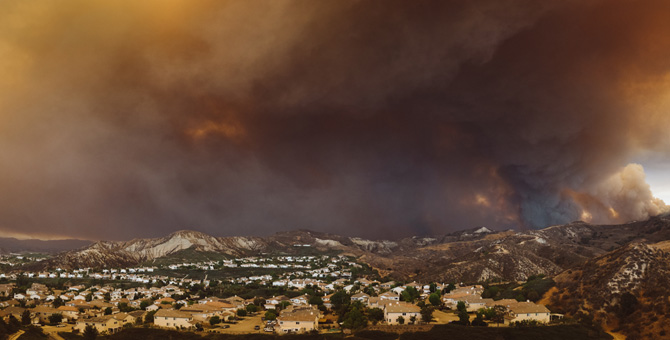Since the release of the SF Fed Research Brief Disruptions from Wildfire Smoke: Vulnerabilities in Local Economies and Disadvantaged Communities in the U.S. last November, heavy1 wildfire smoke has continued to increase across the United States. The latest data shows that 2023 has the potential to be the worst for smoke, according to records we used for the research brief, which extends back to 2011. Just how bad is the smoke? We haven’t seen the end of wildfire season, which typically extends throughout the fall months, and—extending the analysis done in the Research Brief—we find 2023 is already the second worst year on record for light and heavy smoke and the worst for medium smoke.
To better understand how stakeholders across the Twelfth District are navigating the economic impacts of increasing wildfire smoke and their actions to build resilience to these impacts, the SF Fed hosted a webinar in August to share the research and hear from community leaders. We hosted two panels with industry, small business, and community leaders who shared concrete examples of how wildfire smoke has impacted local economies, as well as some promising practices to increase economic and community resilience. Here are our top takeaways.
- Wildfire smoke is changing small businesses, industries, and regional economies.During our first panel, Natalie Collins of the California Association of Winegrape Growers (CAWG), a trade group for an industry which generates over $170 billion for the U.S. annually, shared the losses they experienced during the 2020 wildfires. CAWG estimates that losses from smoke included hundreds of thousands of tons of unharvested grapes, valued at $601 million, with total industry losses exceeding $3.5 billion. She also described the emerging science of how grapes are changed by smoke, demonstrating that even vineyards unaffected by fires may suffer from smoke’s impacts.Another panelist, Executive Director of the Ashland Chamber of Commerce Sandra Slattery, provided examples of how wildfire smoke a few years back affected tourism and businesses in Ashland, a vibrant town located in the mountains of Southern Oregon. She noted that the closure of outdoor venues and attractions due to smoke had “significant financial impact,” even though it was only for a few days. She also mentioned the impact of smoke on vulnerable populations like the elderly and children—and the lack of protocols on the smoke thresholds that would trigger recommendations for closures or keeping people indoors.
“We’d had smoke in the past from fires, but this was coming much too frequently,” said Slattery. “We said to ourselves, ‘We thought we were prepared, but we have a lot more work to do.’”
Both Ashland and CAWG have engaged in new partnerships, sought out new solutions, and developed new tools to better prepare their communities and to help them become more resilient to the effects of smoke and fire. CAWG has also been active with other trade organizations and researchers through new efforts like the West Coast Smoke Exposure Task Force.2
For those in the wine industry, noted Collins, the impact of wildfire smoke on the health of labor force has been a particular concern. Efforts to limit exposure to smoke are underway—including training on proper mask usage—but she said the industry over time has also moved towards more mechanization.
“The winegrape industry is a labor-intensive crop,” she said. “We’ve seen, even before wildfire smoke, issues with accessing vineyards—whether it’s high heat and it’s just not suitable for our workforce to be out there, and then we were met with things like smoke. So, we’re trying to come up with solutions that limit any kind of potential harm in the vineyard.”
- Timely data is crucial to making protective decisions and taking proactive steps to increase community resilience.A theme that emerged from the event was the need for more timely information in order for communities and businesses to best respond and prepare to wildfire smoke events. CAWG, for example, highlighted the wine industry’s need for timely smoke testing so that growers can make informed decisions as to whether or not they should harvest their crop. One of the new resources developed by the Ashland Chamber of Commerce and the community in the past few years include the Smokewise Ashland webpage3 that provides the air quality index, what it means for residents, and resources for preparing for and mitigating wildfire smoke.In our second panel conversation, practitioners working with communities around the District also highlighted the critical need for information. Dr. Elizabeth Walker, Principal of Smoke Ready Solutions and Advisor to Clean Air Methow/Okanogan Clean Air, shared that her rural communities scattered across the complex terrain of mountains and valleys of North Central Washington experience frequent and persistent heavy smoke, but information on local air quality was once difficult to find. Her organization, Clean Air Methow, aims to help address this challenge through a program that distributes low-cost air quality sensors throughout the region.4 These sensors, placed outdoors and indoors, cost around $250 each and upload real-time air quality data to a public website. This allows individuals to make more informed decisions about where and when to use protective equipment, such as masks or indoor air filters, or can help organizations like schools, daycares, and sports teams decide when it is safe to hold events outdoors.
“These sensors have so much potential for small business resilience,” said Walker. “They help businesses verify that their own indoor spaces are healthy for employees and customers. Businesses can engage with tourism and be able to talk about how to seek clean air and have a healthy visit—whether hiking, shopping, or enjoying an event—during smoke.”
- Demand is high for programs that help vulnerable and smoke-burdened communities build resilience to wildfire smoke.The webinar highlighted several other examples of programs that serve as models for how to help vulnerable communities mitigate impacts of wildfire smoke, including the California Air Resources Board’s pilot program to provide funding for clean air centers.5 Areana Flores, program lead at the Bay Area Air Quality Management District, said the funds from the program could be used for relatively inexpensive projects like buying portable air cleaners or replacing air filters, or more expensive projects like retrofitting HVAC systems. The program, already in high demand, has so far resulted in over 1,000 portable air cleaners, or approximately 330 clean air centers in the Bay Area alone, and it prioritizes publicly accessible spaces and vulnerable and smoke burdened communities.“Some of our partners ended up repurposing existing cooling centers to also function as clean air centers,” said Flores. “These centers can essentially serve as multipurpose facilities, or ‘resilience hubs’, and that would not only serve as shelters during air pollution, but also as hydration centers, warming centers, places where people can access power and the internet—this could become a very valuable resource to communities during climate or other emergencies.”
Keegan McChesney, program officer at Rural Local Initiative Support Corporation (LISC) shared ways that LISC’s Health Housing Initiative6 is prioritizing resilience to wildfire smoke in their healthy housing projects, in which they’ve invested more than $3.8 M since 2015, working with community partners across rural America.
“Low-income residents across the country are much more likely to live in poor quality, inadequate, or substandard housing, and they may lack the resources or agency to address those deficiencies,” said McChesney. “Investments to address these deficiencies are vital for the health of these residents, and according to research from the Federal Reserve Bank of Philadelphia,7 the estimated total cost of addressing the physical deficiencies in the U.S. housing stock is nearly $150 billion.”
Two of LISC’s projects last year addressed smoke resilience: Opal Community Land Trust8 in Washington is renovating 12 one-bedroom rental apartments to improve ventilation, heating and cooling to improve indoor air quality, and the Human Resource Development Council (HRDC) in southwest Montana is upgrading an 8-unit senior housing center that will improve indoor ventilation systems to help build resident resilience to extreme heat, as well as wildfire smoke events.
The data and trends are clear: Wildfire smoke and its impacts continue to be felt across the country, and not just in those communities directly experiencing the fires. What we learned from our panelists throughout this event is that many organizations in the Twelfth District are at the forefront of the work to build economic resilience, particularly in communities that are most vulnerable to smoke. The panelists also emphasized that because communities can often experience severe impacts of multiple hazards—fire, heat, and drought or flood, in addition to smoke— relationships, plans, and preparations made in response to one hazard or event can often serve to make them more resilient to others. As our work to study the economic implications of increasing smoke and other hazards continues, we will continue to look to community and business leaders to share promising practices with the broader public.
1. Plume densities reported in data from the National Oceanic and Atmospheric Administration correlate with concentrations of fine particulates (<10 μg/m3 categorized as light, 10–21 μg/m3 as medium, and >21 μg/m3 as heavy).
2. California Association of Winegrape Growers, “CA Wildfire Resources,” https://www.cawg.org/Wine1/Shared_Content/Resources/Wildfire_Smoke/Wildfire_and_Smoke_Exposure.aspx.
3. Smokewise Ashland, https://www.ashland.or.us/Sectionindex.asp?SectionID=534.
4. Clean Air Methow, Methow Valley Citizens Council, “Clean Air Ambassadors Network,” https://www.cleanairmethow.org/get-involved.
5. California Air Resources Board, “Wildfire Smoke Clean Air Center Grant,” https://ww2.arb.ca.gov/our-work/programs/wildfire-smoke-clean-air-center-grant/about.
6. Rural LISC, “Healthy Housing Initiative,” https://www.lisc.org/rural/our-work/housing/healthy-housing-initiative/.
7. Divringi, Eileen(2023), “Updated Estimates of Home Repairs Needs and Costs and Spotlight on Weatherization Assistance,” Federal Reserve Bank of Philadelphia, https://www.philadelphiafed.org/community-development/housing-and-neighborhoods/updated-estimates-of-home-repairs-needs-and-costs-and-spotlight-on-weatherization-assistance.
8. Rural LISC (2017), “Introducing OPAL Community Land Trust,” https://www.lisc.org/rural/regional-stories/introducing-opal-community-land-trust/.
The views expressed here do not necessarily reflect the views of the management of the Federal Reserve Bank of San Francisco or of the Board of Governors of the Federal Reserve System.

